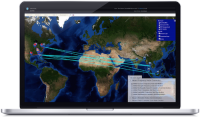There was a time not long ago when most of the food Americans ate came from close to home. Consumers primarily ate what was in season and there were less processed and manufactured foods in general. That has all changed. Our world is more accessible, people are traveling more frequently, and as they do, they are also expanding their palates. Consumers can have Thai food for lunch, Ecuadorian for dinner, and enjoy fresh produce year round regardless of the growing season near home. Similar changes in diet and consumption patterns can be observed across the world. This global “shrinking” (globalization) demands longer and more complex food supply chains to move product and provide ingredients.
Attend the Food Safety Supply Chain Conference | June 12–13, 2018 | Rockville, MD | Learn moreTo support changes in consumer demands, food supply chains that support movement of ingredients and products from farm to fork are becoming increasingly global, dynamic and complex. These supply chains are comprised of complicated networks of farms, production or processing facilities, and storage and distribution channels with product moving via road, rail, ship and air across the globe. These supply chains provide the global food and agriculture sector with efficient access to suppliers and consumers around the world. Unfortunately, however, food supply chains are vulnerable to disruptions such as natural disasters, transportation hazards, cyber attacks, product contamination, theft and unexpected shutdowns of key supply chain nodes. Any of these disruptions could lead to significant public health and economic consequences.
Many supply chain risks and vulnerabilities are directly related to the way a supply chain is constructed. First, there are often several degrees of separation between the point of production and the source of raw ingredients with limited visibility of the pathways in between. Spices are an illustrative example of this supply chain challenge. Spice supply chains are notoriously long with product moving through a complex web of farmers, brokers, processors, wholesalers and exporters. By the time a spice reaches a manufacturer for use in a processed food product, the manufacturer may have adequate visibility and information only about the supplier from whom the spice was most immediately purchased. The manufacturer may not have good visibility of supply chain components further upstream. Depending on the nature of the manufacturer’s customers and distribution channels, the same manufacturer may also have limited visibility of downstream supply chain components. This limited visibility up and downstream could be true for every step of the chain. Without end-to-end supply chain visibility, stakeholders cannot adequately assess risks related to supplier quality and reliability. Tracing product forward and backwards becomes a very difficult task. In the event of a supply chain disruption or contamination event, limited supply chain visibility not only impedes mitigation and response efforts, but also exacerbates the event.
Second, supply chains are often constructed in such a way that certain components of the supply chain are more critical than others. For example, a supply chain may rely upon a single manufacturing plant through which all ingredients and all finished product are routed; a shutdown or failure at that point in the supply chain would greatly impact normal operations. Likewise, a supply chain may rely exclusively on a particular transportation route; a disruption to that route from a disaster could significantly delay delivery of product to consumers. A supply chain may also source the majority of a raw ingredient from a single supplier; a disruption to that supplier could force a producer to scramble to identify and vet alternative suppliers.

Forward-thinking approaches are needed to address supply chain challenges related to supply chain complexity and poor visibility. While some supply chain risks cannot be avoided entirely, understanding supply chain structure and proactively identifying supply chain hazards based on the structure of the supply chain will ultimately improve supply chain resilience. For example, end-to-end, geo-spatial mapping of the supply chain of a particular product line would allow stakeholders to identify risks such as exclusive reliance upon a single supply chain node. However, such an approach is not easy. End-to-end geo-spatial mapping of a supply chain requires data and information from multiple stakeholders. Sharing information across organizations is both culturally and logistically difficult.
To address these challenges, the Food Protection and Defense Institute (FPDI) has developed technology that allows private food companies and the government to document, visualize and compare supply chains in support of risk and criticality assessments, mitigation efforts and event response. With support from the Department of Homeland Security, FPDI developed CRISTAL or Criticality Spatial Analysis. CRISTAL is a geo-spatial web application that allows organizations to document supply chains from end-to-end, including supply chain components owned by other entities such as suppliers or distributors. Additionally, CRISTAL allows users to visualize the geo-spatial structure of a supply chain alongside hazard layer data, including cargo theft and natural disaster hazards. By increasing supply chain visibility, CRISTAL ultimately facilitates supply chain documentation, product tracing, and event response. Finally, CRISTAL supports efforts to identify where mitigation resources are most needed during potentially catastrophic supply-chain failures.
More information about the CRISTAL technology is available on the FPDI website. Organizations interested in using the technology may contact FPDI at fpdi@umn.edu.



